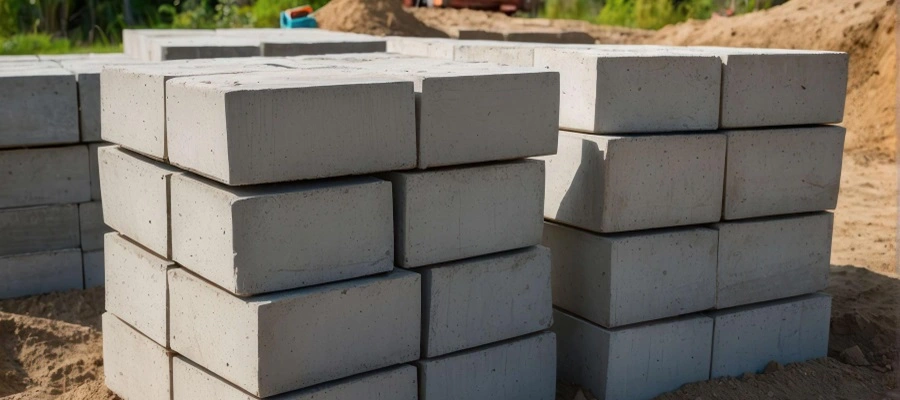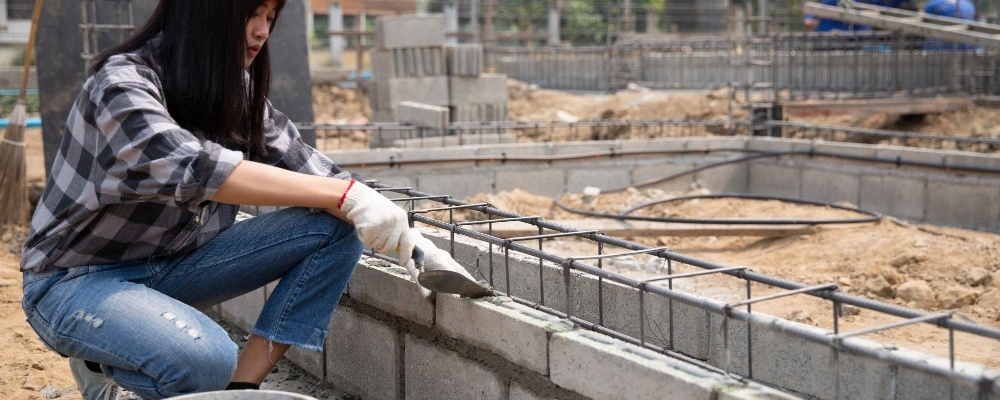The construction industry is ever-evolving, making innovation and efficiency the primary drivers of progress. Recently, autoclaved aerated concrete (AAC) blocks have gained significant attention for their versatility and benefits. These eco-friendly, lightweight, precast, low-density blocks transformed the way construction firms construct buildings, offering a sustainable alternative to traditional building materials.
Successfully developed by Swedish architect Dr. Johan Axel Eriksson in 1924, AAC blocks replaced wood. This superb building material has similar properties to wood. These green building materials provide an edge over wood for building structures without causing any decay, termite damage and combustibility.
In this blog, Brick & Bolt focuses on the essentials of AAC blocks. It further discusses the various types of AAC blocks, their properties, advantages, application, maintenance, and future trends and innovations. Whether you are a builder or architect, understanding AAC blocks provides valuable insights into creating stronger and more sustainable structures.
What are AAC Blocks?
Autoclaved aerated concrete (AAC) blocks emerged as a revolutionary building material that changed the way of constructing the buildings. Their lightweight and durability helped it emerge as an excellent building material. Manufacturers combine cement, fine aggregates, water and an expansion agent in the manufacturing of these blocks. The expanding agent is primarily aluminium powder or paste, which reacts with other ingredients to create small air pockets.
Manufacturers then pour the mixture into moulds and cure it in an autoclave, which uses high pressure and steam to harden the blocks, this process is known as steam curing. The final material obtained is a versatile and eco-friendly building material that is ideal for wider applications. AAC blocks are five times lighter than traditional concrete and contains approximately 80 percent air.
Types of AAC Blocks Used in Construction
Just like the types of bricks, manufacturers tweak these blocks slightly to suit the requirements of various projects. Whether you require these blocks for fire resistance, thickness, or durability, there’s an AAC block type for you.
(I) Fire Resistant AAC Blocks:
Builders use these blocks in construction where fire resistance is essential. If safety is the top priority in your construction, this fire-resistant material is perfect for the project since it offers excellent fire protection.
(II) 100mm AAC Blocks:
If your construction project requires a thinner wall structure, the 100mm blocks are the ideal choice. While providing construction versatility, these blocks retain their advantages.
(III) 200mm AAC Blocks:
Does your construction require more insulation or thicker walls? Then, 200mm AAC blocks are the best choice for building insulation. Their increased thickness offers more strength and insulating capacity.
(IV) Long-Lasting AAC Blocks:
These blocks are the best solution for buildings that require longer life. Their time-tested engineering guarantees your construction long-term strength and durability.
(V) Rectangular Fly Ash AAC Blocks:
These types of concrete blocks are the best choice for sustainable building practices and are best suited for projects that try to incorporate building materials that do not harm the environment. The blocks’ advantages are enhanced by using fly ash, a waste by-product. Using these blocks in a building’s construction makes them an environmentally responsible option.
Properties of AAC Blocks

The properties that make AAC blocks a preferred choice for construction include the following:
Dimensional Tolerance
AAC blocks possess the highest surface texture combined with the lowest dimensional tolerance. That is why they are ideal for load-bearing and non-load-bearing applications.
Thermal Conductivity
The high thermal resistivity and low thermal conductivity make AAC blocks a popular choice in the construction industry. The code specifies a maximum limit of 0.24W/m.K. AAC blocks play a significant role, as they protect the occupants from the outside heat. When compared to traditional clay bricks, AAC blocks are more resistant to heat. This helps the occupants save on air conditioning costs over their lifetimes. Besides, these blocks help keep the building cool.
Dry Density
When placed in an oven at 105°C for a long period, the AAC block does not reduce in weight. After almost 36 hours, you can measure its dry density. The process is vital as manufacturers make these blocks using heat treatment through steam. Besides, even after autoclaving, these contain residual moisture. Therefore, it’s necessary to check the oven-dry density to choose the one suited for your project.
Fire Rating
Fire safety has become a prime concern in modern construction. Today’s builders and the leadning construction firms in Delhi consider AAC blocks superior building materials. This is because these blocks score high in terms of fire-rating concrete. The melting point of these blocks is 1500°C, which is over twice the temperature of fire in a building.
Advantages of Autoclaved Aerated Concrete Blocks
The following are the advantages of these blocks.
Self-Heat Insulation
AAC blocks have an inner insulation value of R30. Therefore, they offer the best performance. Since these blocks contain aluminium, the metal prevents the creation of hydrogen from combusting when it interacts with calcium hydroxide. When you construct structures using these blocks, the occupants require fitting fewer air conditioners and blowers, aiding in effective energy conservation.
Low Density
Since AAC blocks are lightweight, they are ideal for transport and use in constructing buildings. When compared to traditional red bricks and concrete, they are 30 to 35 per cent lighter. The decreased dead lads of the AAC blocks aid in the construction of taller buildings. These types of concrete blocks offer superior workability, which is another benefit, helping to reduce construction investment and overall expenses.
Flexibility
When compared to the AAC blocks vs red bricks, AAC blocks come in varies sizes, you can easily replace the traditional bricks with a few of them. It shortens the project’s duration, as you do not need time for installation and laying. When compared to other concrete buildings, these blocks reduce the requirement to add more joints. As you can adjust these blocks in various ways, including cutting, nailing and drilling, they offer better flexibility.
Earthquake Resistant
Nowadays, people are becoming more conscious and demanding of designing structures that can withstand seismic waves. Autoclaved aerated concrete blocks are ideal for this demand. To understand how AAC is suitable for it, you must understand the factors for earthquake-resisting houses. For example, a structure’s weight directly correlates to the force of an earthquake, and the lightweight structure of the blocks is safer than other structures.
Pest Resistance
Manufacturers construct AAC blocks from inorganic materials. Therefore, it protects against damage from rodents, termites and other pest infestations. Besides, it prevents the development of molds inside the building.
Application of AAC Blocks in Construction
Builders in Bangalore use autoclaved aerated concrete, mostly as concrete masonry units. These are economical in large-scale projects with wide use in civil and industrial construction. Builders use these for walls, floors, and roofs. Some of the uses of AAC blocks in construction include the following:
- Construction of residential and commercial buildings.
- Since these blocks have excellent insulation properties, they are best suited for external walls.
- Multi-storeyed construction and viable even for a five-storeyed construction.
- You can build entire residential areas using autoclaved aerated concrete blocks.
- You can also use this construction material as your interior blocks. Since they are very levelled, you can finish them with a thin coat of plaster.
- Builders can also use these blocks to create kitchen surfaces, as they are easy to remove without damaging the surroundings.
Maintenance and Care of AAC Blocks
You must do the following to maintain your AAC block structure.
1. Annual Examination:
Ensure that the structure is examined annually by professionals. This will help you take proactive measures to resolve any issues arising with the structure.
2. On-Time Repairs:
Is your structure experiencing degradation? Check it for the presence of cracks and other damages. Take immediate action to stop further degradation.
3. Frequent Cleaning:
Washing your AAC block surface with water and detergent helps maintain the shine.
4. Effective Drainage:
In case of a waterlog, drain the water properly. Leaving water in the system for a long time might damage the material.
5. Pest Control:
Often pests invade structures. If you relate to this, take immediate actions to control pest infestation; else, it might harm your AAC blocks.
6. Sealing Integrity:
The occupants might experience lack of insulation in the building. If that’s the case, inspect and maintain the sealing of joints and connections to ensure insulation and energy efficiency.
Future Trends and Innovations in AAC Block Technology
With a wide range of applications and a reduction in carbon footprint, autoclaved aerated concrete blocks have emerged as the best materials in the construction industry. They are revolutionary building materials for green buildings, require less material, are durable, and produce minimum waste. Besides, they can tackle common inherent challenges, including noise and uneven terrain. Therefore, AAC blocks’ roles might grow exponentially in the construction industry.
Conclusion
The lightweight, insulating, and eco-friendly autoclaved aerated concrete blocks revolutionized the landscape of present-day construction. As the most preferred choice for sustainable and efficient building materials, AAC blocks offer a wide range of applications, from residential projects to large-scale infrastructure. As a leading construction firm in India, Brick & Bolt offers design-to-build services. The best part of the organization is that you get real-time tracking, quality checks, effective communication with the project manager, and regular updates on your projects from the first day until their completion. I addition, you can also calculate your home construction cost by using an online cost estimator for free. Brick & Blot focuses on and practices a sustainability approach and, therefore, incorporates innovative construction materials like autoclaved aerated concrete (AAC) blocks for project construction.

